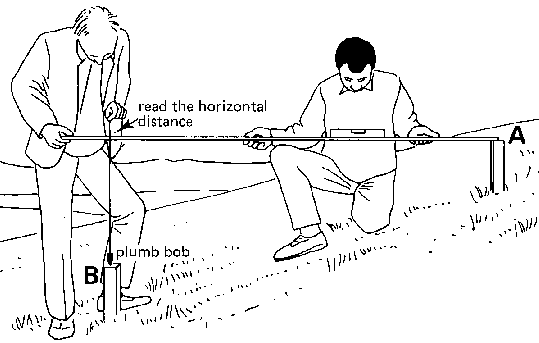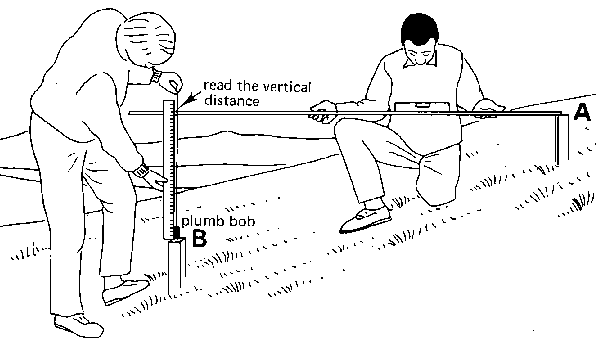3.1 Measuring Short Distances
3.2 Measuring Long Distances
3.3 Measuring Distances in Tall Vegetation
3.4 Measuring Horizontal and Vertical Distances in Steep Sloping Areas
This section indicates, step by step, how to measure short distances, long distances, distances in tall vegetation and horizontal and vertical distances in steep sloping areas.
To measure distances in a field (for example the length and width of a field), a chain or a measuring tape is used. Two men are required, the back man, holding the zero point of the chain (or the tape), and the front man, holding the other end of the chain.
The following procedure is used when measuring a distance which does not exceed the total length of the chain or the tape.
Step 1
Pegs are placed to mark the beginning and the end of the distance to be measured.
Step 2
The back man holds the zero point of the chain (or tape) at the centre of the starting peg.
The front man drags his end of the chain (or tape) in the direction of the second peg. Before measuring, the chain (or tape) is pulled straight (see Fig. 15).
Fig. 15 Measurement of a short distance
Any knots in the tape or entangled links in the chain result in errors in the measurement,
Step 3
When using a measuring tape, the distance between the two pegs can be read directly on the tape by the front man.
When using a chain, the number of links between the two pegs is counted. The total distance is equal to the number of links multiplied by the length of one link (20 cm).
|
Distance = number of links x length of one link |
EXAMPLE: Calculate the distance when given that 30 links have been counted and the length of one link = 0.2 m.
ANSWER: Distance = number of links x length of one link = 30 x 0.2 = 6 m
Very often, the distance to be measured is longer than the length of the chain 01 the tape. The front man is then provided with short metal pins, called arrows. The arrows are held together by a carrying ring. These arrows are used to mark the position of the end of the chain (or tape) each time it is laid down.
The procedure to follow when measuring long distances is:
Step 1
Pegs are placed (A and B) to mark the beginning and the end of the distance to be measured, and ranging poles are set in line with A and B.
Step 2
The back man holds the zero point at the centre of the starting peg (A). The front mar drags his end of the chain (or tape) in the direction of peg (B). Directed by the back man, he stretches the chain, in line with the ranging poles. Then he plants an arrow to mark the end of the chain (or tape) (see Fig. 16a).
Step 3
Both men move forward with the chain (or tape) and the procedure is repeated, the back man starting this time from the arrow the front man has just planted (see Fig. 16b).
Step 4
The procedure is repeated until the remaining distance between the last arrow and the peg (B) is less than one chain length (see Fig. 16c).
Fig. 16a Measurement of a long distance Step 2
Fig. 16b Measurement of a long distance, Step 3
Fig. 16c Measurement of a long distance, Step 4
Step 5
The remaining distance is measured using the procedure as described in section 3.1.
The number of arrows used during the procedure represents the number of times the full length of the chain (or tape) has been laid out.
The total distance measured is then calculated by the formula:
|
Total distance |
= number of arrows used x length of the chain (or tape) |
|
|
+ distance between the last arrow and peg B |
EXAMPLE
The distance between two pegs (A) and (B) has been chained. When reaching peg (B), the back man has used 7 arrows. 23 links have been counted between the last arrow and peg (B), What is the total distance between peg (A) and peg (B)?
Givennumber of arrows used by the back man = 7
length of the chain = 20 m
number of links between the last arrow and peg (B) = 23
length of one link = 20 cm = 0.20 mAnswer
Distance between the last arrow and peg (B) = number of links x length of one link = 23 x 0.2 = 4.6 m
Total distance = (number of used arrows x chain length) + (distance between last arrow and peg B) = (7 x 20 m) + 4.6 m = 144.6 m
Distances may have to be measured in a field where a tall crop or tall grass is cultivated. The measuring tape (a chain would be too heavy) must then be stretched horizontally by the two men above the crop.
When measuring distances it is important to keep the tape horizontal. Push two arrows or two pegs into the soil to mark the distance to be measured (see Fig. 17). Plumb bobs can be used to check if the measuring tape is indeed horizontal. If horizontal, the free hanging plumb bobs (immediately above the arrows) are perpendicular to the measuring tape. In other words, the measuring tape and the plumb bobs form right angles.
Fig. 17 Measurement of a distance in a tall growing crop
When measuring distances in a field, reference is always made to horizontal distances. In flat areas, these (horizontal) distances can be measured directly. In steep sloping areas, however, it is Incorrect to assume that the distance measured over the ground surface is the horizontal distance. Thus the horizontal and vertical distances have to be measured separately.
A measuring rod (see Section 1.2), a plumb bob (see Section 1.3) and a carpenter level (see Section 1.4) are used to measure short horizontal and vertical distances in steep sloping areas for example between peg 1 and peg 2 of Fig. 18a.
The procedure to follow is:
Step 1
Two pegs (A and B) are driven into the soil in such a way that their tops are at the same height above the ground level (see Fig. 18a).
Fig. 18a Measurement of horizontal and vertical distances, Step 1
Step 2
The zero point of the rod is placed on top of peg A. A carpenter level is placed on the rod; move the end of the rod up or down until the bubble of the level is between the marks: the measuring rod is horizontal (see Fig. 18b).
Fig. 18b Measurement of horizontal and vertical distances, Step 2
Step 3
Hang a plumb bob just above the centre of peg B and read the horizontal distance on the measuring rod (see Fig. 18c).
Fig. 18c Measurement of horizontal and vertical distances, Step 3

Step 4
The measuring rod is maintained horizontal. The vertical distance between peg A and peg B is measured with a ruler or tape along the plumb bob, from the top of peg B to the bottom of the rod (see Fig. 18d).
Fig. 18d Measurement of horizontal and vertical distances, Step 4

Often, however, the distance between the two pegs is longer than the length of the measuring rod. In this case, intermediate pegs are. placed in line with A and B, at intervals of not more than one rod length (see Fig. 19a).
To measure the distances between all the intermediate pegs, steps 1 to 4 (see above) are repeated.
Fig. 19a Measurement of horizontal and vertical distances when using intermediate pegs, Step 1
Fig. 19b Measurement of horizontal and vertical distances when using intermediate pegs, Step 2
The total horizontal (or vertical) distance between pegs A and B is the sum of the horizontal (or vertical) distances measured between all the intermediate pegs (see Fig. 19b).
Total horizontal distance: 1.85 + 1.75 + 1.52 = 5.12 m
Total vertical distance: 0.72 + 0.35 + 0.47 = 1.54 m